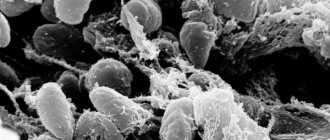Flow
The duration of a cold depends on the person’s age, the state of his immune system, as well as the type and strain of the virus that causes the disease.
Typically, ARVI without complications lasts no more than a week. In this case, the acute period of the disease, during which a person suffers from fever and other manifestations of intoxication, lasts 2-3 days. At the same time, there are colds in which the acute period is mild, as well as those in which the disease persists for 10-14 days. The “fast” ones include rhinovirus infection, and the “long-term” ones include parainfluenza and adenoviral infection, however, their duration also differs from individual to individual.
What is a complication?
Complications are pathologies that arise against the background of the underlying disease. The complication is associated with the underlying disease, and does not simply appear in parallel with it. The following factors contribute to the occurrence of complications:
- violation by the patient of the treatment plan, diet, sleep and rest patterns;
- ignoring the disease - lack of treatment (for example, in adults, complications of acute respiratory viral infections often develop as a result of suffering the disease “on your feet”);
- inappropriate treatment, often self-medication;
- premature refusal to take medications;
- weakened immunity of the patient;
- physiological characteristics (for example, in people with a deviated nasal septum, a common complication after ARVI is sinusitis).
The cold is one of the diseases against which many serious diseases develop. The complications that arise can be much more dangerous than the cold itself. Some consequences of ARVI require surgical intervention (for example, sinusitis), and some require long-term treatment (for example, arthritis).
There are early complications of infections that occur during the acute period of the disease, and late complications that occur some time after the symptoms of the underlying disease have subsided.
What complications can there be?
Anyone who has encountered pathology is interested in the question of what complications there may be after the flu. With proper and timely therapy, the patient will begin to recover within a week. But if you do not follow all the doctor’s instructions, this can result in health problems.
Let's look at what complications there are after the flu.
- Pneumonia. It can be observed both during the illness and after recovery a couple of days later. A weakened immune system simply cannot cope with the army of microbes in the upper respiratory tract. If pneumonia is a complication of the flu, symptoms will include a very high fever, pain and tightness in the chest, and shortness of breath. As soon as the disease begins to gain momentum, it is no longer possible to do without hospitalization. Around-the-clock therapy and regular medical supervision will be required.
- Kidney diseases . Complications of influenza in adults can also affect the excretory system. In this case, severe back pain and dark urine are observed. But not everyone will take these symptoms seriously. If the fight is not started in a timely manner, it may result in kidney failure. If, after recovery, the temperature rises sharply again, swelling of the limbs and eyelids occurs, and a frequent urge to urinate appears, this is a serious reason to consult a doctor.
- Heart diseases . Doctors say that the flu is related to the formation of atherosclerotic plaques, problems with blood clotting, the occurrence of blood clots, and inflammation of the walls of blood vessels. Such pathological processes begin to occur when viruses enter the blood. They disrupt the natural circulation of blood, increasing the load on the heart. This leads to severe pain in the heart. You cannot do without medical help, since the lack of therapy can provoke myocarditis. Even worse, the process will provoke a heart attack or acute heart failure.
- Neuralgia, arachnoiditis, neuritis . The nervous system is very sensitive and easily susceptible to viruses. The fact that it was this system that caused complications after the flu in adults is indicated by such symptoms as severe headaches, cramps in the limbs, pain in the joints and muscles, pain when moving the eyeballs, and strong sweating.
These are just the main complications that are very dangerous for both adults and children.
Possible complications
What diseases can develop in a person suffering from a viral infection? Complications can be divided into two groups:
- respiratory diseases;
- diseases of organs outside the respiratory system.
Most often, complications of ARVI in children and adults affect the ENT organs.
By their nature, complications can be divided into the following groups:
- viral - damage by the virus to previously unaffected organs (meningitis, viral pneumonia);
- bacterial - the addition of a secondary infection (tonsillitis, bacterial rhinitis, pharyngitis, etc.);
- toxic - damage to organs or tissues by microorganism waste products;
- autoimmune - if damage to an organ or tissue is caused by a person’s own immune system, the activity of which is distorted by the influence of the pathogen (for example, after streptococcal sore throat, the immune system can attack heart tissue, since the proteins of the heart valves and the cell wall of streptococcus have a similar structure).
Some bacterial complications that develop after ARVI, mainly in adults, become chronic diseases. Thus, bronchitis, arthritis, neuroinfections and other diseases can become chronic.
Complications of ARVI
Complications of ARVI are the most dangerous component of this, at first glance, safe cold phenomenon. A virus that has entered the body and caused unpleasant catarrhal symptoms can cause intoxication of the entire body, disrupting the normal course of physiological processes.
Due to the fact that a sick person does not follow the recommendations given by the doctor, or does not start or does not start drug therapy in a timely manner, the risk of developing additional diseases caused by the penetration of a bacterial infection into the body increases. It is precisely this development of events that makes acute respiratory viral infections so dangerous.
The concept of complications after illness
Complications are considered to be the consequences of intoxication during ARVI, which caused the development of pathological processes due to the existence of an untreated disease. Such phenomena can develop under the influence of a number of factors:
- violation of the drug therapy regimen prescribed by the doctor;
- failure to comply with bed rest and restriction of activity (even despite the presence of a feeling of weakness during ARVI);
- independent choice of pharmaceuticals for treatment;
- taking medications incorrectly;
- premature cessation of medication use due to improvement in the person’s condition;
- severely weakened immunity;
- the presence of physiological characteristics of the body, when the infection and virus multiply rapidly and contribute to the development of inflammatory processes.
An acute respiratory viral infection, accompanied by a runny nose and sore throat, is perceived by many people as just another cold that may not be treated, and yet, after a week, it will go away.
In fact, this disease, without proper attention to it, is fraught with serious consequences, the onset of which can be recognized by dire signs (shortness of breath during ARVI, resumption of elevated body temperature, sore throat and severe cough).
Complications develop especially often in the following groups of people:
- children aged from one to three years;
- old people;
- having serious chronic pathologies (diabetes mellitus) or disorders in the functioning of the circulatory system;
- have recently undergone surgery;
- suffering from immunodeficiency or autoimmune diseases (HIV, systemic lupus).
Diagnosis of complications after ARVI
Complications of ARVI can develop unnoticed, which is why it is so important to visit a doctor at the first signs of the disease, as well as after 5-7 days, especially if disturbing symptoms arise.
The doctor makes a diagnosis of acute respiratory viral infection after examining the sick person, ascertaining his symptoms accompanying the disease, and also paying attention to the general epidemiological situation in the city.
To determine the presence of complications, the medical professional examines the patient:
- reveals signs of inflammation on the conjunctiva of the eyes, nasal mucosa, and oropharynx;
- listens to breathing, determining the presence of wheezing in the lungs (this is important for determining obstructive bronchitis), assesses heart rhythm and heart rate;
- listens to patient complaints.
After this, the specialist may recommend taking tests to diagnose the presence of the disease:
- general and biochemical blood tests;
- general urine analysis;
- performing ultrasound (pelvic organs, urinary system, abdominal organs);
- taking an electrocardiogram;
- X-ray examination (lungs, sinuses);
- obtaining consultations from a neurologist, otolaryngologist, gastroenterologist, cardiologist.
Important! Complications that develop as a result of the disease should not be diagnosed independently. The presence of a bacterial infection in the body must be confirmed by tests and studies, only in this way will the doctor be able to prescribe adequate therapy that will quickly get the person back on his feet.
Possible complications after ARVI
To avoid the development of ARVI with abdominal syndrome, the appearance of pneumonia or tonsillitis, it is important to follow these rules:
- Observe bed rest, visits to work, school, shops are prohibited. Only in this way can the body find the internal reserves necessary to fight the virus;
- maintain a cool temperature and sufficient air humidity in the apartment (at 20 degrees and 70%): this is necessary to ensure that the mucous membranes are always moisturized. If you follow this rule, the mucous membranes will actively fight viruses, and the attachment and reproduction of the latter will be greatly hindered;
- drink a lot and often of warm liquid (tea, fruit drink, compote, juice, herbal decoction): this is necessary to speed up the process of removing toxins from the body and avoid the process of dehydration;
- Bacterial complications of ARVI can be avoided if you regularly carry out wet cleaning of all surfaces of the room where the patient is.
Complications that arise after a viral infection are divided into two types:
- respiratory diseases;
- diseases of internal organs.
The nature of the occurrence of complications allows us to distinguish several types:
- Viral, when dangerous microorganisms penetrate further into the body, affecting previously uninfected tissues. Such diseases include ARVI with symptoms of meningism and viral pneumonia.
- Bacterial, when an additional infection is attached to the virus (rhinitis, pharyngitis, laryngitis, tonsillitis, sinusitis, otitis media).
- Toxic, with damage to internal organs, disruption of their normal functioning, under the influence of toxins that penetrate the blood from the activity of viruses.
- Autoimmune, when the damage is caused by one’s own immunity, which perceives foreign bacteria as its own cells.
It is important not to trigger the development of complicated processes, which often requires the prescription of antibacterial therapy.
Antibiotics are not used to treat acute respiratory infections caused by a virus. But they work best against bacteria, which most often cause the development of concomitant diseases.
If, 3-5 days after the onset of the disease, the acute symptoms do not subside, moreover, the patient’s condition worsens, which can be caused by the layering of a bacterial infection on a viral one, the prescription of antibacterial drugs is indicated.
As a rule, specialists use drugs that have a wide spectrum of action for treatment. This is necessary so that the treatment is more likely to give a positive result, but there is no time to determine the specific entity that caused the development of the disease.
To combat complications, the following antibacterial agents are prescribed:
- group of aminopenicillins (Amoxiclav, Flemoxin Solutab, Augmentin);
- cephalosporins (Cefix, Zinnat, Cefodox).
Consequences of ARVI on the respiratory system
Influenza pneumonia accompanying ARVI, pharyngitis or laryngitis are the most common complications affecting the respiratory system.
Bacterial complications arising from the respiratory system can be as follows:
- Acute tonsillitis (tonsillitis, sometimes with purulent plaque): the affected area is the pharynx, as well as the tonsils. After the body begins to fight the virus, a bacterial infection may occur, which will provoke the appearance of the following symptoms: an increase in thermometer readings, the appearance of severe pain in the larynx, which intensifies during talking and swallowing, and the appearance of a whitish coating. Sore throat is a disease that can also provoke complications from the heart and kidneys (this can be pyelonephritis, myocarditis, rheumatism).
- Sinusitis, sinusitis , affecting the paranasal sinuses, with the accumulation of sputum in them during ARVI, which is purulent in nature. In winter, when you are in an apartment with central heating, the mucous membranes dry out, which provokes the active reproduction of infection on them. In the presence of such pathologies, a person may lose the ability to smell, complain of severe headaches, and a feeling of pressure in the bridge of the nose and forehead. The acute course involves an increase in body temperature, which normalizes after the disease becomes chronic. Moreover, discharge from the nasal passages is not necessarily present. The main danger of these pathologies is the proximity of inflammatory foci to the brain, which can lead to inflammation of the meninges, which can be fatal.
- Rhinopharyngitis or chronic rhinitis, when the lymph nodes in the neck are enlarged during ARVI, are a sign of an inflammatory process occurring in the nasal cavity. This condition manifests itself with a severe runny nose and cough, most often occurring in the morning.
- Otitis media manifests itself as severe pain in the ears, and perhaps both one or both hearing organs are affected. Acute otitis media is difficult to miss, but untreated otitis is fraught with serious complications in the form of complete hearing loss.
- ARVI with obstructive syndrome can occur when a bacterial infection descends to the bronchi. When an acute condition develops, for example, bronchitis with purulent processes, a cough with green sputum may be observed. People with chronic diseases of the respiratory system are especially prone to developing this pathology.
- Pneumonia (pneumonia) is one of the most serious complications that develops after a viral infection. Such a diagnosis can be made only after a comprehensive examination of the person. Characteristic symptoms may be a severe cough and fever that does not go away for a period exceeding 10 days.
Consequences of ARVI on other organs
A severely advanced acute respiratory infection may well cause the development of other pathological conditions from different systems of the human body:
- When your back hurts during ARVI, this may be a sign that the infection has spread to the organs of the urinary system. In cases where the patient does not comply with the heavy drinking regimen prescribed by the doctor, the infection and toxins are not washed out and removed from the body, but penetrate into the kidneys and bladder. This is accompanied by the occurrence of the following symptoms: severe pain in the lumbar spine, increased body temperature, discomfort, pain accompanying the process of urination, swelling of the tissues of the face and limbs. To slightly reduce the unpleasant symptoms, you should take a warm bath and start using diuretics. It is mandatory to undergo a general urine test and maintain the treatment prescribed by the doctor.
- Loose stools during ARVI are a sign that there is ARVI with abdominal syndrome. This condition is accompanied by abdominal pain and disruption of the digestive tract.
- When your legs hurt or your neck hurts during ARVI, you can assume the development of rheumatoid arthritis. This pathology affects the joint tissues, which causes unpleasant, sometimes intolerable, sensations in the legs, knees, and feet. Over time, rheumatoid arthritis (in the absence of adequate drug therapy) can move from the legs to the lungs, cardiovascular system, liver and kidneys, which can lead to a serious deterioration in a person’s condition.
- Neuroinfection is perhaps one of the most dangerous complications that develops after a viral infection. The infection, in this case, penetrates the meninges and affects their structure. The process of inflammation can paralyze a person or cause his death. Signs of the development of a terrible disease are: dizziness and lethargy, a feeling that teeth hurt due to acute respiratory viral infections, attacks of severe headaches, and body temperature remaining at 37.5 degrees for a long time.
The concept of a temperature tail after ARVI
Complications of ARVI in adults can accompany the common cold, so respiratory diseases should not be treated without due attention, leaving them to chance, and without seeking medical help.
The presence of a chronic infection in the body, especially during an epidemic, can cause not only damage to the respiratory system and ears, but also cause other disorders of the human condition.
For example, medicine knows cases when elevated body temperature can, after an acute respiratory viral infection, remain between 37 and 37.5 degrees for a week or two, after all other symptoms have disappeared.
This state is called the temperature tail.
In principle, this condition is not dangerous, although it should alert a person. After all, an increase in thermometer readings is always a sign of the presence of an infection in the body or an inflammatory process.
Therefore, a mandatory visit to a doctor is required, who, after conducting the necessary examinations, will be able to name the cause of this condition. He will also prescribe drug therapy, if necessary.
Most often, a person simply does not have enough strength to recover quickly. After all, the body, after a viral infection and toxins that have entered the blood, is greatly weakened. To help him recover, it is necessary to adhere to bed rest, drink plenty of fluids, and also take vitamin supplements.
Situations where the temperature, on the contrary, is below normal, are also not correct. Most likely, the matter will be a severe weakening of the immune system. The problem can be solved with hardening procedures, walks in the fresh air and vitamin therapy.
In order for any respiratory infection to pass quickly and without unpleasant consequences for the body, it is very important to promptly seek medical help and strictly adhere to all recommendations received from the doctor.
Source: https://bezgrippa.com/orvi/oslozhneniya-orvi/
Respiratory complications
Most often, bacterial complications of the respiratory system develop against the background of a cold. After an acute respiratory viral infection, children often develop a sore throat, bronchitis, etc.
The most common secondary pathologies of the respiratory organs are:
- Sore throat, or acute bacterial tonsillitis - inflammation of the tonsils. You can get tonsillitis both in winter and in summer (as a result of drinking very cold drinks, etc.). Sore throat is dangerous because it can, in turn, cause complications in other organs. A severe complication of streptococcal tonsillitis is rheumatism. This is a lesion of the connective tissue of the joints and heart. At the same time, sore throat itself is a serious illness, accompanied by intoxication, fever and severe sore throat. In infants, sore throat can even cause suffocation.
- Sinusitis and other sinusitis are inflammations of the paranasal sinuses. If after an acute respiratory viral infection you have lost your sense of smell, your head and eye area hurt, especially when bending over and making sharp turns, you should visit an ENT specialist. In acute sinusitis, the body temperature rises greatly, but in chronic sinusitis it can remain normal. Sinusitis threatens permanent loss of smell, as well as the spread of infection to nearby organs - the middle ear, eyes and even the brain. It should be noted that with sinusitis, a runny nose is not always observed, since often the mucus cannot come out of the sinuses (due to swelling of the mucous membrane, blocking the exit from the sinus by a deviated septum, etc.).
- Inflammation of the lower respiratory tract - bronchitis and pneumonia. After ARVI, the cough sometimes does not go away for quite a long time - 10-14 days. If you cough up phlegm, you are probably on the road to recovery. If, after an acute respiratory viral infection, you are bothered by a dry cough, or a cough with impurities of pus or blood in the sputum, you should worry. A repeated increase in temperature at this time confirms the suspicion of a secondary infection.
- Chronic rhinitis, nasopharyngitis - inflammation of the mucous membrane of the nasal cavity and pharynx. They manifest themselves as a frequent runny nose, or as a runny nose and cough in the morning and at night (in the lying position, the sputum formed on the mucous membrane cannot flow into the esophagus, accumulates and clogs the airways).
Complications after ARVI: causes, consequences and their diagnosis
ARVI is an acute respiratory viral infection, which is based on inflammatory processes. They arise due to the penetration of viruses into the respiratory system. ARVI usually includes: adenovirus, rhinovirus, parainfluenza and influenza infections.
All these diseases are accompanied by moderate intoxication of the body. As a result, the patient experiences symptoms in the form of fever, aches in the muscle structures, pain in the head and throat, cough, runny nose and nasal congestion.
If a patient ignores the signs of the disease and does not begin the treatment process, he risks complications after ARVI.
The concept of complications after illness
A complication is usually called a pathological process that manifests itself as a result of an untreated disease or untimely treatment. Adverse consequences result from several factors. This includes.
- Violation of the treatment process or regimen.
- Ignoring the disease. The patient does not begin treatment, or suffers the disease on his legs.
- Incorrectly prescribed treatment or self-medication.
- Premature discontinuation of medications at the slightest improvement.
- Severely weakened immune function.
- Physiological characteristics of the patient. For example, a deviated nasal septum.
ARVI is one of the types of colds, against the background of which many serious complications arise. When adverse consequences develop, a person exposes himself to danger. They lead to surgery, paralysis or death.
Diagnosis of complications after ARVI
Unfortunately, when a patient does not follow the doctor’s recommendations or does not begin treatment, he himself leads to the development of complications. To determine their presence, you need to visit a doctor. After conducting an examination and listening to complaints, the doctor will prescribe an examination, which includes the following.
- Donating blood for general and biochemical analysis.
- Submission of urine for general analysis.
- Carrying out ultrasound examination.
- Carrying out electrocardiography.
- Conducting an X-ray examination.
- Taking a swab from the mouth and nasal cavity to determine the infection.
- Consultation with a neurologist and otolaryngologist.
Only after the examination will it be possible to understand the presence of a complication. After this, a treatment regimen will be prescribed, which will necessarily include antibiotics.
Possible complications after ARVI
Many patients do not think about what complications of ARVI may arise in those who suffer from a viral infection. In practice, complications are usually divided into two types.
- Respiratory disease.
- Diseases of internal organs.
Often complications after ARVI in adults and children affect the respiratory system.
By nature, the consequences are divided into the following types.
- Viral. The virus infects tissues that were not previously affected. This includes meningitis or viral pneumonia.
- Bacterial. In such a situation, a secondary infection occurs. These include bacterial rhinitis, pharyngitis, and acute tonsillitis.
- Toxic. Internal organs are damaged by microbial waste products.
- Autoimmune. The damage is caused by the immune system itself, since antibodies perceive foreign cells as their own.
Consequences of ARVI on the respiratory system
Complications of ARVI are often observed that affect the respiratory system. They are bacterial in nature. These include:
- Acute tonsillitis.
This disease is popularly called angina. It affects the area of the pharynx and tonsils. The disease occurs due to hypothermia of the throat when inhaling cold air, eating ice cream and activating bacteria. The main symptoms of the disease include: a rise in temperature to 39-40 degrees; severe pain in the throat that occurs when swallowing and talking; loss of voice; the formation of whitish or yellowish plaque. In this case, tonsillitis can cause severe complications in the form of myocarditis, pyelonephritis and rheumatism. - Sinusitis and sinusitis. The disease affects the paranasal sinuses, which are located in the cheeks and forehead. If during ARVI in adults and children the olfactory function has disappeared, the head hurts severely and pressure appears in the eyes, then these are sure symptoms that the patient is developing sinusitis. If the disease is acute, the patient will experience an increase in temperature to 38-39 degrees. In chronic cases, the temperature remains within normal limits. Sinusitis is dangerous because the inflammatory process can spread to the nearest membranes, where the ear, eyes and brain are located. It is worth noting that sinusitis does not always cause a runny nose. The patient may have a stuffy nose, and mucus accumulates inside the sinuses and does not come out due to the resulting plug.
- Inflammatory process in the lower part of the respiratory system in the form of bronchitis and pneumonia. After a cold, a cough can persist for up to two to three weeks. Recovery is indicated by sputum coming out of the bronchi. If this does not happen or you cough with blood or pus, you should immediately consult a doctor.
- Chronic rhinitis or nasopharyngitis. These diseases indicate the formation of an inflammatory process in the nasal cavity and pharynx. Manifests itself in the form of frequent runny nose and cough in the morning.
Consequences of ARVI on other organs
If ARVI is severely advanced, the complication can also affect internal organs. The most common ones include the following.
- Otitis.
The inflammatory process occurs in the ear. It can be external, middle and internal. It is quite easy to recognize the disease by frequently occurring pain in the ear area. The disease appears seven to fourteen days after a cold or flu. In this case, otitis media is characterized by symptoms in the form of: severe pain in the ear; shooting pain; hearing impairment; temperature rises to 38 degrees; formation of pus and crusts. - Nephritis, pyelonephritis.
ARVI can spread to the kidneys. This complication occurs if the patient does not comply with the drinking regime and, as a result, the infection begins to spread in the kidneys. In this case, the patient experiences symptoms in the form of: pain in the lumbar region; swelling of the facial area and limbs; frequent urination, which causes severe pain. First of all, the kidneys need to be given a little rest. To do this, you should purchase special herbal tea and take a warm warming bath. If the patient's temperature rises and the urine becomes cloudier, this indicates pyelonephritis. Then you need to urgently consult a doctor. - Rheumatoid arthritis. The disease affects a person's joints, as a result of which he may have pain in his legs or knees. After some time, rheumatoid arthritis ceases to be a banal complication on the legs. The disease begins to affect the heart, kidneys and lungs.
- Neuroinfection.
This type of disease is considered the most dangerous. Neuroinfection affects the meninges and nerve tissue. The inflammatory process can lead to paralysis or death. The main symptoms include: dizziness; lethargy; constant headaches; temperature within 37.5 degrees, which lasts for a long time.
The concept of a temperature tail after ARVI
In medicine, there is such a thing as a temperature tail. After suffering from acute respiratory viral infection, the temperature may remain within 37-37.5 degrees for several days or weeks. In this case, other symptoms are completely absent. It is worth noting that the temperature tail is not an adverse effect. But it completely disappears only after ten to fourteen days.
But you need to remember that a slightly elevated temperature may indicate that there is a sluggish infectious process in the body. Therefore, it will not be a bad idea to visit a doctor.
https://www.youtube.com/watch?v=pbD9KH5d7OE
If the patient’s temperature, on the contrary, is very low and stays within 35.5-36 degrees, then this indicates that the immune function is greatly weakened.
The body simply does not have enough vitamins to improve its condition. The patient needs to be introduced to a special fortified diet and take vitamin complexes.
It is also worth thinking about maintaining a healthy lifestyle, carrying out hardening procedures and exercises.
Tips and tricks
Source: https://przab.ru/bolezni/orvi/vozmozhnye-oslozhneniya.html
Complications on other organs
- A complication of the middle ear that occurs during ARVI is otitis media. This is inflammation of the middle ear. Acute otitis media is accompanied by severe pain, which is simply unbearable to endure. Usually people with otitis media do not put off going to the doctor. Otitis media manifests itself 7-14 days after ARVI. First, the ears are blocked, then aching pain, tingling, and “crackling” appear in the ears. With otitis media, pus accumulates in the middle ear area, between the eardrum and the auditory ossicles. This threatens hearing impairment (if bacteria damage the surface of the auditory ossicles). If a lot of pus accumulates, it can rupture the eardrum, and the ability to hear in that ear will be lost forever. Don’t tolerate ear pain – otitis media can be cured in the hospital in just a couple of days.
- Also, kidney complications are often observed after ARVI. For example, nephritis is an inflammation of the kidney tissue. Symptoms of nephritis are aching pain in the lower abdomen and back, swelling of the face, wrists and ankles. It is necessary to give the kidneys a rest - buy anti-inflammatory urological herbal tea, take a warm bath. If the pain in the lower back is severe, the temperature rises, and the urine becomes cloudy, the renal pelvis is probably inflamed. This disease is called pyelonephritis. In this case, you need to go to the hospital as soon as possible, because impaired kidney function causes severe intoxication.
- If your legs and knees hurt after an acute respiratory viral infection, perhaps the acute respiratory viral infection caused complications in the joints. Rheumatoid arthritis is an autoimmune disease. After suffering from acute respiratory viral infection, the joints hurt because they are affected by the person’s own immune system. Over time, rheumatoid arthritis ceases to be just a “complication of the legs after ARVI” - it affects the lungs, heart, and kidneys. The joints become weakly mobile, muscle strength rapidly fades away. This is one of those diseases whose early symptoms should never be ignored.
- Neuroinfections are perhaps one of the most dangerous diseases, the impetus for which are viral and bacterial infections. Neuroinfections include inflammation of the membrane and tissues of the brain and spinal cord, as well as peripheral nerves. What symptoms indicate a neuroinfection? You should be wary of nausea, lethargy, dizziness, headache, low-grade fever that appears after suffering a severe acute respiratory viral infection or bacterial infection.
The flu is not as bad as its complications
“A sore throat will harm the heart: you can’t do without antibiotics”
— Among the complications of acute respiratory viral infection (ARVI), bacterial and viral pneumonia most often develop. The main symptoms appear already on the third day after infection, explained our permanent expert, infectious disease doctor, leading researcher at the Federal Research Center for Epidemiology and Microbiology. Honorary Academician N.F. Gamaleya, Doctor of Medical Sciences, Professor Nikolai Aleksandrovich MALYSHEV. — Viral pneumonia often develops due to an upper respiratory tract infection and is accompanied by high fever, shortness of breath, cough, sputum production, and respiratory failure. Against the background of ARVI, there can be such dangerous complications as meningitis, encephalitis, glomerulonephritis and even sepsis - blood poisoning with bacterial pathogens.
A sore throat can also develop as a complication of ARVI. This is a very common disease known to many firsthand. “Sore throat” symptoms of intoxication are very similar to the flu: high fever, body aches, headache, chills or fever, redness of the throat. Even with an uncomplicated course, it goes away in at least two to three weeks. However, like the flu, it itself is dangerous due to its complications. The most common are myocarditis (inflammation of the heart muscle), rheumatism, nephritis (inflammation of the kidneys), etc. The situation is typical for those who have reduced immunity, especially during the cold season.
Therefore, if a sore throat occurs, you should not self-medicate, but seek help from a doctor. Only a doctor can decide how and with what to treat it. After all, the forms and types of sore throat are different, up to severe ulcerative and gangrenous types. Moreover, a serious infectious disease such as diphtheria can occur simultaneously with a sore throat. Today in our country this pathology is becoming more common, not only in children, but also in adults. And the mortality rate from it is quite high. It is not easy for even a doctor with extensive experience to distinguish a “simple” sore throat from a sore throat due to diphtheria: an accurate diagnosis can be made only after culture from the tonsils.
And if the diagnosis of “angina” is established, it is better to be treated at home, observing bed rest. Complications such as rheumatic myocarditis and nephritis tend to develop in those who have had a sore throat on their legs. And since sore throat is caused not only by viruses, but also by bacteria, antibiotics will be required to cure it. But only a doctor can decide which ones, what their dosage should be, how often and for how long to take them.
Ultraviolet irradiation of the tonsils and the back wall of the pharynx (known as UF) has a good effect on angina.
Auxiliary means. Since the source of inflammation is within reach in the throat, sore throat germs can be fought with home methods. Gargling with solutions of soda, table salt, chamomile infusion, and furatsilin are effective. You can - several times a day. And also - gargling with warm water and honey (1 tablespoon of honey per glass of water), inhalation over hot water with soda, etc. Propolis also helps with sore throat: its grains should be chewed slowly after eating.
Plus - anti-inflammatory herbal infusion. Recipe: mix 2 tbsp. St. John's wort, chamomile, 3 tbsp. lavender and celandine. Take 3 tbsp. collection, pour a liter of boiling water, leave for 40 minutes. Gargle with warm broth up to 10-12 times a day, in severe cases - every 30 minutes. After rinsing, take the infusion orally: 1 tbsp. several times a day.
“Viral tonsillitis can affect the kidneys, lungs and liver.”
One of the complications of influenza is viral tonsillitis. This is a special type of inflammation of the submandibular tonsils, which most often occurs after the flu, our expert explained. Its causative agents are viruses that penetrated the nasopharynx and caused inflammation in the tonsils. As you know, the purpose of the tonsils is to protect the body from infections, but as a result of the development of inflammatory processes, they lose this function. Later, bacteria can join the viral infection and cause bacterial tonsillitis.
Children are more often susceptible to this disease, because... their immune system is not yet formed. Such a “childhood” infection is more difficult to fight, and it is not diagnosed immediately. At first, the symptoms of influenza and ARVI appear more clearly. But a more thorough examination of the throat reveals inflammation of the tonsils and plaque on them.
The symptoms of viral tonsillitis are approximately the same as those of a sore throat: acute sore throat, redness, swollen lymph nodes, plaque on the tonsils, fever. If no action is taken when the first signs of the disease appear, the infection will go deeper into the body, which is fraught with other complications: bronchitis, pneumonia. If this case is not treated correctly, the disease can become chronic: serious problems with the functioning of the liver, kidneys, and heart will appear.
In this case, it is necessary to carefully examine the patient, paying special attention to the condition of the nasopharynx and lymph nodes, the expert advises. The sick person must undergo a blood test, a throat swab, and an ECG of the heart. The patient should be consulted by an infectious disease specialist and an allergist. Treatment of viral tonsillitis should be largely aimed at eliminating the symptoms of influenza, ARVI or other infections that gave rise to this disease. Treat the disease that became the background for the development of sore throat.
The basis of treatment is antiviral drugs. Antibiotics are not suitable - they are only suitable for the treatment of bacterial tonsillitis; these drugs will not have the desired effect on the infection, explains Professor Malyshev. If therapy is carried out correctly, the symptoms of tonsillitis will go away along with the symptoms of the underlying disease. There will be no trace of a sore throat. Recently, laser beams have been effective in targeting tonsils.
Auxiliary means. Anti-inflammatory collection of herbs for gargling: St. John's wort, oak leaves, wild strawberry, celandine - 2 tbsp. spoons. 3 tbsp. Pour a liter of boiling water over spoons of the mixture and leave for 40 minutes. Gargle up to 10 times a day and take the infusion orally, 2 tbsp. spoons up to 10 times a day. The infusion can also be used for inhalation.
However, with prolonged inflammation of the tonsils, and especially when complications of chronic and viral tonsillitis occur, the tonsils will have to be removed.
Photo: Natalia Gubernatorova
“Pharingitis and laryngitis reduce hearing”
A sore throat can also signal that inflammation of the walls of the pharynx and larynx has begun, infectious disease specialists say. Inflammation of the pharynx is called pharyngitis, and inflammation of the larynx is called laryngitis. These diseases are a consequence of delayed treatment of influenza. They are often combined both with each other and with sore throat. The main symptoms are pain when swallowing, a tickling and dry throat, as well as a constant desire to cough. If the inflammation is severe, hoarseness of the voice may appear, and sometimes its complete loss. When inflammation spreads to the Eustachian tubes connecting the pharynx with the ear cavity, hearing decreases and ear pain may occur.
With severe inflammation, swelling of the neck may develop, and the cervical lymph nodes will increase significantly. The temperature usually does not rise much and chills are rare, which indicates that there is no pronounced general intoxication in the body. With severe laryngitis, severe swelling of the laryngeal mucosa may occur and breathing will be difficult. Treatment of pharyngitis is the same as for angina, with antiviral drugs. Plus rinsing (including a 10% salt solution), inhalation, drinking plenty of fluids to remove microbial toxins.
But in children, whose airways are much thinner than in adults, laryngitis can cause acute obstruction of the larynx, requiring urgent measures, including surgery.
You should also know, the expert warns, that sore throat, dryness, soreness, hoarseness and other signs of inflammatory diseases of the larynx and pharynx can also occur with tumors, including malignant ones. Therefore, there is no need to get carried away with self-medication. If symptoms of pharyngitis or laryngitis do not go away, despite forced treatment, you should definitely go to the doctor. The examination in most cases is quite simple: after examining it with a special mirror, the doctor will be able to make a conclusion. Under no circumstances should you neglect an examination by an ENT doctor.
Auxiliary means. Collection: take 4 tbsp. agrimony, wild mallow, as well as 100 g of black currant berries and 100 g of honey. Brew the herbs, infuse, strain. Mix the infusion with berries and honey and leave for 7 days in a dark place. Take 1 tbsp. spoon 3 times a day. Do inhalations. Gargle up to 6 times a day.
Another collection: take 4 tablespoons of eucalyptus, coltsfoot, and sage. 3 tbsp. collection, pour a liter of boiling water. Insist. Take 2 tbsp. decoction 6 times a day and gargle with this infusion between doses. Before going to bed, take inhalations. For dryness and sore throat, add 1 tbsp for inhalation. sunflower oil. After inhalation, do not go outside for an hour.
But if there is a violation of the airway associated with laryngitis, it is dangerous to treat yourself: you must definitely call an ambulance.
And now - attention! The main difference between the flu and a cold: immediately after infection - high (up to 40 degrees) temperature, unbearable headache, severe weakness, severe cough, acute pain in the throat and chest. With a cold, the symptoms increase gradually, after several days or even a week: first - a runny nose and a slight sore throat, then, in the evenings, a slightly elevated temperature. When dealing with the flu, experts do not advise people who are sick to lower their body temperature unless it is higher than 38 degrees. This is explained by the fact that by lowering the temperature, a person suppresses the activity of the body’s defenses.
At the end of the day: a real flu epidemic is possible this year
...The flu of the fall-winter 2018 epidemic season is the arrival of new mutated strains of the virus that can infect a huge number of people in a short time, according to world experts. Each of the new pathogens has mutated and become more dangerous and unpredictable. The peak of the disease will occur in late autumn and the coming winter. But a start has already been made: in Russia, including Moscow, ARVI diseases have already been recorded.
Unfortunately, those infected with the influenza virus often consider the disease to be harmless and try to treat themselves. It is categorically impossible to do this: statistics show that up to 500 thousand people die every year in the world due to a frivolous attitude towards ARVI and influenza. In Russia, fortunately, deaths from influenza are rare, but they also happen.
And the most effective protection against the flu is vaccination, says our expert, famous infectious disease doctor Nikolai Malyshev.
By the way, in the capital, at the beginning of October, more than 16% of residents had already been vaccinated, as reported by the head of the Rospotrebnadzor department for Moscow, Elena ANDREEVA. According to her, in the 2018–2019 season. It is planned to vaccinate at least 60% of the city’s population free of charge, that is, approximately 7.6 million Muscovites. A year earlier, a flu epidemic in our city was avoided, as approximately 56% of Muscovites were vaccinated against this virus.
Today, Muscovites can get vaccinated for free not only in clinics at their place of residence, but also in 70 city centers, at 34 metro stations, at suburban railway stations and even in large shopping centers. In total, more than 500 mobile points will operate.
Temperature tail
It is also worth mentioning the phenomenon in which after an acute respiratory viral infection the temperature remains at 37-37.5 C. There are no other symptoms of the disease. This condition is called the “temperature tail” after ARVI. Temperature tail is not a complication. It usually subsides within a couple of weeks after recovery. However, an elevated temperature after an acute respiratory viral infection may indicate a sluggish continuation of infectious processes. To make sure that the disease is behind you, it is recommended to take general clinical blood and urine tests.
If there is a focus of infection in the body, this will certainly be reflected in many test indicators.
If everything is normal, there is nothing to worry about.
By the way, some experts believe that low-grade fever after a cold persists in those people who have weakened immunity. This also applies to those whose temperature is lowered after an acute respiratory viral infection - 35.5-36 C. A fortified diet after suffering from the disease, as well as strengthening the body through hardening and physical exercise, will not be superfluous.











